Supercheap SSDs
While high-end SSDs still command top-shelf prices, there’s plenty of lower-priced options.
Josh Collins tests 12.
Something that the age of solid- state has made abundantly clear is that the hardware you use for storing data plays a key role in a PC’s overall system performance. The storage medium can have a profound impact on system responsiveness and the user experience. Simply switching your OS drive from a comparatively slow mechanical hard disk drive (HDD) — be it 5,400rpm, 7,200rpm or even 10,000rpm — to a solid-state drive (SSD) can make a huge, positive difference to how you work or play.
The immediate positives to be taken from swapping out an HDD for a SSD include significantly improved read and write speeds, smaller and lighter drive footprints, drastically improved shock resistance and, for mobile device users, increased battery life due to reduced power consumption in both idle and active states.
When first launched a decade ago, SSDs demanded a high premium for the luxury of the above mentioned attributes. However, over the years, development in SSD technologies and the associated manufacturing techniques have helped put downward pressure on pricing. This has forced cost per gigabyte values to not just dip below the $1/GB mark, but many drives in the entry-level market are nearing the $0.50/GB.
This month, we’ve collected a range of affordable SSDs to test to help you narrow down which ones best suit your needs… and budget.
Table of Contents
- Crucial MX300 (275GB) Review
- Intel SSD 540s Series (120GB) Review
- Intel SSD 540s Series (240GB) Review
- Kingston SSDNow UV400 (120GB) Review
- Kingston SSDNow UV400 (240GB) Review
- Kingston SSDNow V300 (120GB) Review
- Samsung 850 EVO (250GB) Review
- Samsung 850 Pro (256GB) Review
- SanDisk SSD Plus (120GB) Review
- SanDisk SSD Plus (240GB) Review
- SanDisk Ultra II (240GB) Review
- Western Digital WD Blue PC SSD (250GB) Review
- Western Digital WD Green PC SSD (120GB) Review
- Western Digital WD Green PC SSD (240GB) Review
Crucial MX300 (275GB) Review
Unusually sized, but a great combo of value and performance.
This unit uses Micron’s TLC-based 3D NAND paired with Marvell’s 88SS1074 controller. The combo provides an endurance spec of 80TB written, vendor-reported performance figures of 530MB/s sequential read and 510MB/s write, and is available in a range of odd capacities. The MX300 entry-level solution has a capacity of 275GB (competitors usually feature 240–256GB) — this is due to the way Crucial allocates the available memory space using large density 3D NAND ICs and associated attributes such as garbage clean-up and cell over-run.
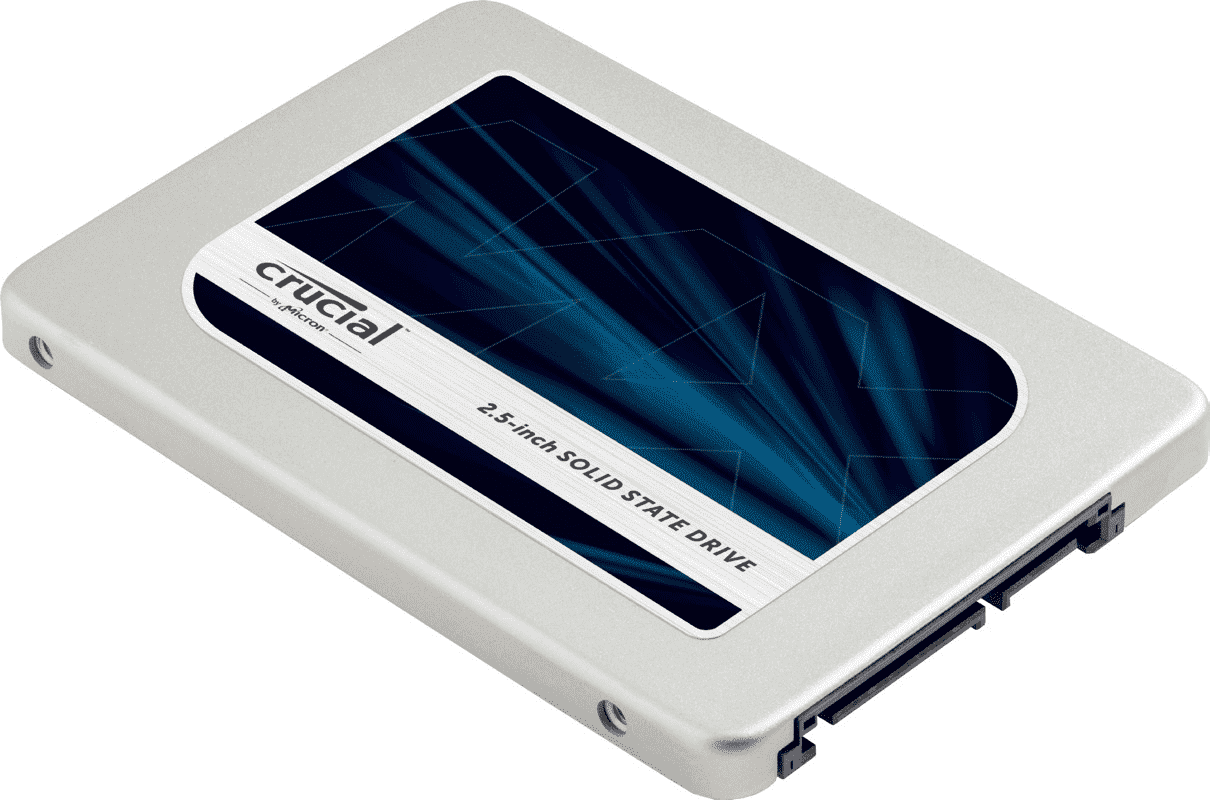
The 275GB drive presents impressive value with a low dollar-per-GB cost of $0.54 that drives attention away from the likes of the Intel 540s and Samsung 850 Pro. This dominance shifts, however, when considering warranty and performance, respectively.
This drive falls behind some of the pack regarding raw performance but is still great value, especially when capacity is key.
Crucial MX300 275GB SATA 2.5 Inch Internal Solid State Drive - CT275MX300SSD1
- Sequential reads/writes up to 530 / 510 MB/s on all file types.
- Random reads/writes up to 92K / 83K on all file types.
- Over 90x more energy efficient than a typical hard drive.
- Accelerated by Micron 3D NAND technology.
- Sequential reads/writes up to 530 / 510 MB/s on all file types.
- Random reads/writes up to 92K / 83K on all file types.
- Over 90x more energy efficient than a typical hard drive.
- Accelerated by Micron 3D NAND technology.
Verdict
Solid value with lots of capacity for the money invested.
Rating 4/5 (Recommended)
Intel SSD 540s Series (120GB) Review
The weak link in the Intel 540s range.
Directly comparing the Intel 540s 120GB and 240GB models, there is a sharp performance deficit for the 120GB model compared to the 240GB.
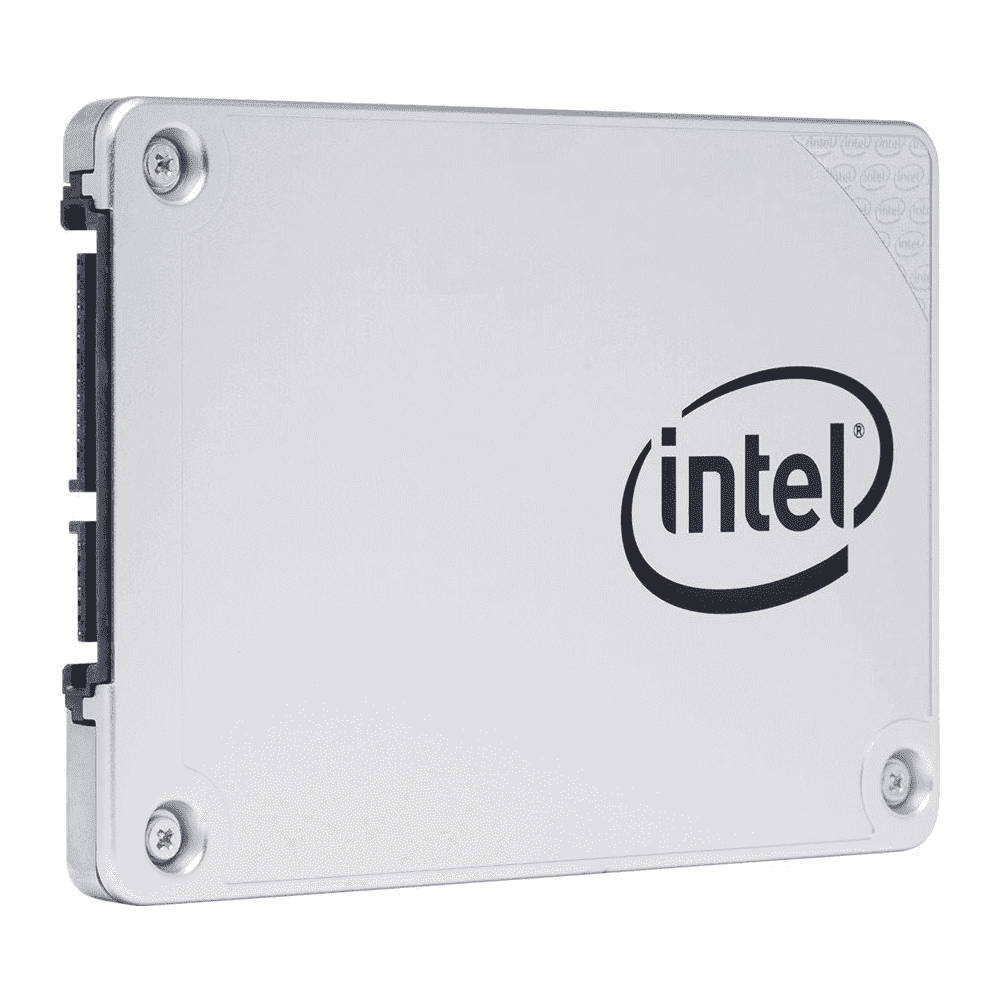
Specifically, this performance deficit relates to the write speed capabilities of the 120GB drive and in benchmarks such as AS SSD that have a summarized score result that reflects a combination of read and write results, the 120GB is left lagging considerably behind the 240GB model. In real world usage, drive writes occur at a significantly lower ratio compared with drive reads and most general users won’t recognize much of the performance deficit.
However, for users dealing with significantly more drive writes in their workloads, the 120GB model will quickly show its slower performance.
Intel Ssd 540s Series 120gb 2.5in Sata 6gb/s 16nm tlc res
The five-year warranty is unique; however, the cost per GB is high and there are better performing options available.
Verdict
Good drive read performance, but lacks write speed and high cost/capacity value.
Rating 3/5
Intel SSD 540s Series (240GB) Review
Brings the expected performance, but not enough.
Featuring improved drive write performance and reduced cost per GB over its 120GB brother (left), the Intel 540s 240GB is the true competitor from Intel to attempt to do battle with the rest of the roundup, especially in the ~240GB category.
Like the 120GB model, though not as extreme, the 240GB model struggles to compete on pricing. The Intel 540s 240GB SSD is the third most expensive per GB in the roundup, beaten to that unenviable crown by its 120GB stablemate and the Samsung 850 Pro — though the latter can justify it.
Intel 540s Series SSDSC2KW240H6X1 240GB 2.5 inch SATA3 Solid State Drive (TLC)
- Intel SSD 540 Series 240GB, 2,5'' SATAIII
- Intel SSDSC2KW240H6X1 solid state drive
- Intel SSD 540 Series 240GB, 2,5'' SATAIII
- Intel SSDSC2KW240H6X1 solid state drive
At a solid 10c per GB more expensive, the read speeds are in line with pricing, yet write speeds are equivalent or slower than cheaper competitors, thereby making pricing a bit of a sticking point.
The saving grace for the Intel 540s 240GB in a competitive category for affordable SSDs is the five-year warranty, only matched or exceeded by the Samsung offerings.
Verdict
While the warranty may push some to buy, its price per GB really is a reason for pause.
Rating 3/5
Kingston SSDNow UV400 (120GB) Review
The 120GB drive you want for peace of mind.
The Kingston SSDNow UV400 120GB still suffers from the lower capacity performance deficit compared with the 240GB version; however, it picks up the slack compared with the Kingston SSDNow V300 (over the page), which, like the Intel 540s 120GB, suffers from low write speeds. However, it’s worth noting that, during testing, the UV400 120GB achieved 360–380MB/s write speeds across CrystalDiskMark 5 and AS SSD and an overall write score that leads the 120GB pack. The reported write speed is above the manufacturer rated 350MB/s, though the drives were all tested empty and that performance degrades as a drive is filled.
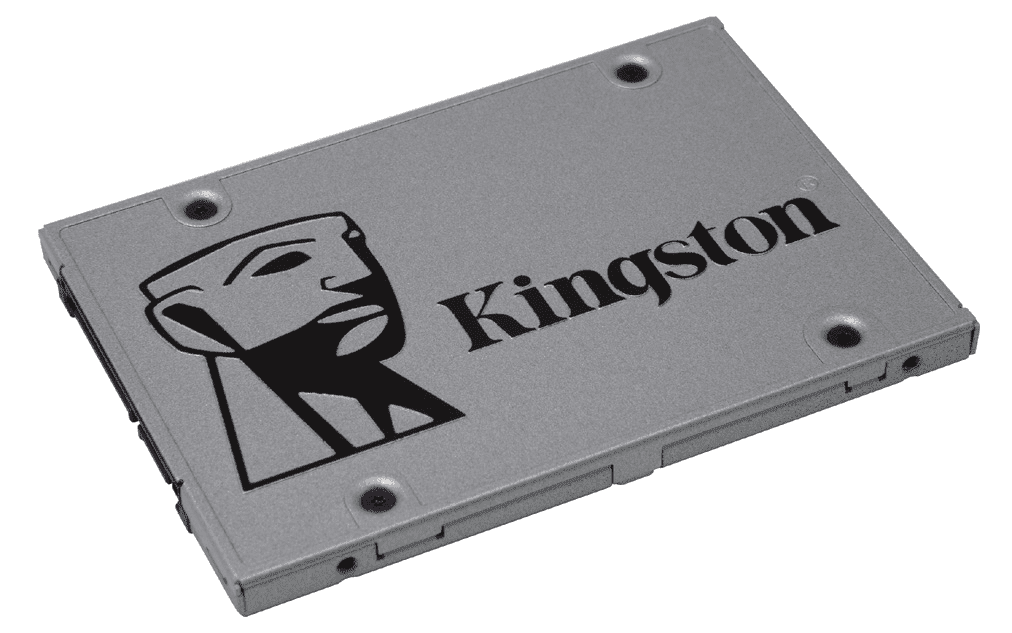
The SSDNow sits at a justifiable price point, though some may be tempted to take the SanDisk SSD Plus route. We suggest sticking with the Kingston option as we experienced a pitifully low random write IOPS in Anvil’s Storage Utilities benchmark for the SanDisk SSD, albeit at a mega queue depth of 64.
Kingston Digital 120GB SSDNow UV400 SATA 3 2.5" Solid State Drive SUV400S37/120G
- Storage Capacity: 120GB SSD
- Form Factor: 2.5 inch. NAND: TLC
- Interface: SATA 3.0 (6Gb/s) – with backwards compatibility to SATA 2.0 (3 )
- Data Transfer (ATTO): Up to 550MB/s Read, and 350MB/s Write
- Dimensions: 100.0mm x 69.9mm x 7.0mm. Weight: 57 grams
- Storage Capacity: 120GB SSD
- Form Factor: 2.5 inch. NAND: TLC
- Interface: SATA 3.0 (6Gb/s) – with backwards compatibility to SATA 2.0 (3 )
- Data Transfer (ATTO): Up to 550MB/s Read, and 350MB/s Write
- Dimensions: 100.0mm x 69.9mm x 7.0mm. Weight: 57 grams
Verdict
Edges out the WD Green for the 120GB category win. But the higher capacity drives are better value for money.
Rating 3.5/5
Kingston SSDNow UV400 (240GB) Review
Fights a tight battle in the center of the value pack.
The UV400 240GB is up against some stiff competition in the lower end of the ~240GB segment, competing with the likes of the Intel 540s, SanDisk SSD Plus and Ultra II and the WD Green.
For the most part, the SSDNow maintains a performance lead over the other contenders, with the SanDisk Ultra II 240GB alongside it in the write speeds achieved during testing.
Generally commanding a lead over the Ultra II in write results, the SSDNow drops behind on read when the queue depth is stacked. It’s due to the stacked queue capability of the Ultra II that, when comparing overall summarized results in AS SSD, it leaps ahead — even compared with the likes of the Samsung 850 EVO and 850 Pro.
Nonetheless, removing this outlying result from the pool, the SSDNow UV400 240GB breaks through the fog to present a valued option and even knocking on the door of the higher performance ~250GB drives.
Kingston Digital SSDNow UV400 240GB 2.5-Inch SATA III SSD (SUV400S37/240G)
- Storage Capacity: 240GB SSD
- Form Factor: 2.5-inch. Interface: SATA Rev. 3.0 (6Gb/S), with backwards compatibility to SATA Rev. 2.0 (3Gb/S).
- Data Transfer (ATTO): Up to 550MB/s Read, and 490MB/s Write.
- Maximum Random 4k Read/Write: Up to 90,000 IOPS and 25,000 IOPS.
- Storage Capacity: 240GB SSD
- Form Factor: 2.5-inch. Interface: SATA Rev. 3.0 (6Gb/S), with backwards compatibility to SATA Rev. 2.0 (3Gb/S).
- Data Transfer (ATTO): Up to 550MB/s Read, and 490MB/s Write.
- Maximum Random 4k Read/Write: Up to 90,000 IOPS and 25,000 IOPS.
- Package Contents: 2.5-inch 240GB SSD. Dimensions: 100mm x 69.9mm x 7mm. Weight: 57 Grams.
Verdict
Considering cost per GB and performance, this model is definitely worth considering.
Rating 4/5 (Recommended)
Kingston SSDNow V300 (120GB) Review
Read the benchmark fine print.
Let’s get straight to the point here: unless you come across this unit at a discounted rate to clear stock, you should stay clear. There are simply better options available in the market for the same expenditure. Only those who don’t do their research end up buying this drive at full price.
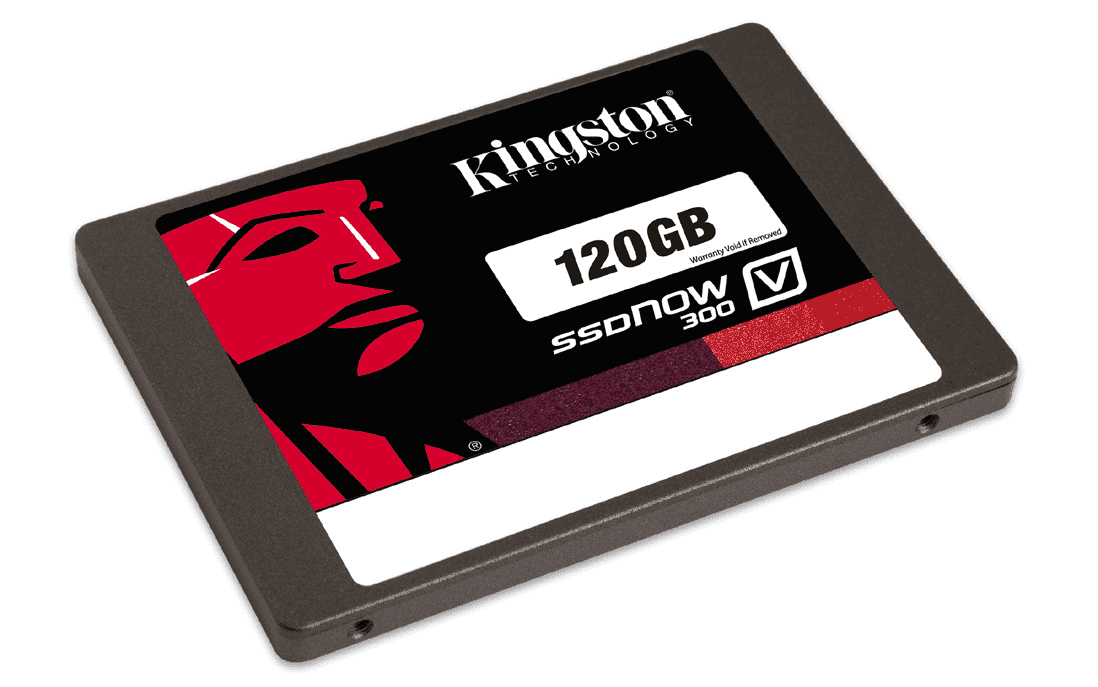
Like with other 120GB drives in this roundup, the V300 incurs a performance hit compared to the larger-capacity models from the same series. However, the vendor-stated specs are low to say the least, listing just 180MB/s read and 133MB/s write.
Our tests found the manufacturer quoted read speed to be far off reality with the drive reaching within the 480–515MB/s range. However, the quoted write speed was much closer to reality, with the drive achieving a meagre 155–166MB/s range. At these speeds, you may as well be using a mechanical drive like a Seagate Barracuda 1TB drive and enjoy eight times the storage capacity.
Kingston Digital 120GB SSDNow V300 SATA 3 2.5 Solid State Drive (SV300S37A/120G)
- Reliable: with no moving parts, solid-state drives are less likely to fail than standard hard drives
- Economical: design optimized to make migrating to an SSD more affordable
- Capacity: 120GB, Interface: SATA Rev. 3.0 (6Gb/s) – with backwards compatibility to SATA Rev. 2.0. 120GB — 180MB/s Read and 133MB/s Write.
- Reliable: with no moving parts, solid-state drives are less likely to fail than standard hard drives
- Economical: design optimized to make migrating to an SSD more affordable
- Capacity: 120GB, Interface: SATA Rev. 3.0 (6Gb/s) – with backwards compatibility to SATA Rev. 2.0. 120GB — 180MB/s Read and 133MB/s Write.
- Form Factor: 2.5-Inch drive available in 7.0mm with plastic adapter to fit in 9.5mm system
- Fast: 10x faster than a 7200RPM hard drive
Verdict
Don’t pay full price for this unit. There are better options out there for the same amount.
Rating 2/5
Samsung 850 EVO (250GB) Review
Nothing wrong with this bride’s maid.
Samsung is doing amazing things in the solid-state storage space, whether it be over SATA or NVMe protocol. With the 960 series dominating the NVMe market, the 850 series has the unenviable task of backing up the 960 monsters on the SATA front.
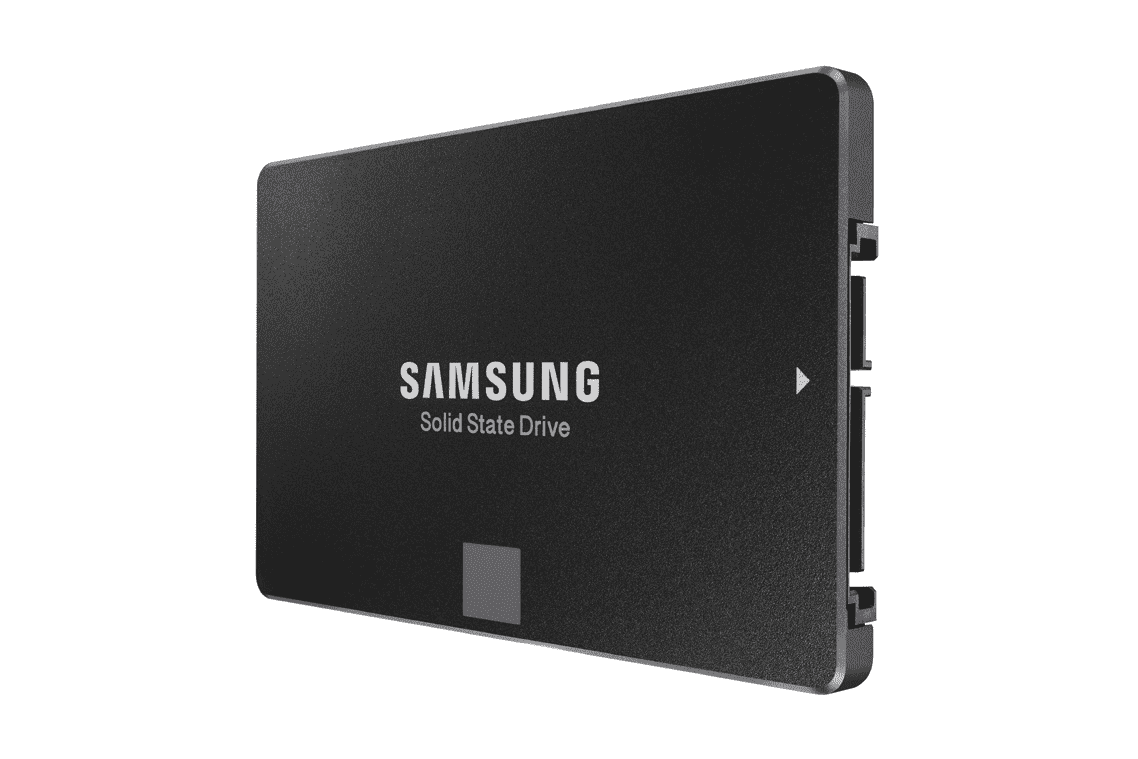
The 850 EVO 250GB presents an entry-level capacity to the Samsung 850 Evo series of SATA SSDs. With performance SATA SSD speeds held back by the storage protocol for the most part, it’s the write speeds that often set units apart. No surprise, then, that the 250GB makes it to the podium in all write tests and takes second to its Pro stablemate (right) in the overall score results for Anvil’s Storage Utilities.
Samsung 850 EVO - 250GB - M.2 SATA III Internal SSD (MZ-N5E250BW)
- The World's First Consumer 3D V-NAND SSD
- Ultimate Read/Write Performance
- Enhanced Endurance and Reliability
- Efficient Power Management supporting DevSleep Mode
- Form Factor: M.2 (80mm) - ideal for mobile computing
- The World's First Consumer 3D V-NAND SSD
- Ultimate Read/Write Performance
- Enhanced Endurance and Reliability
- Efficient Power Management supporting DevSleep Mode
- Form Factor: M.2 (80mm) - ideal for mobile computing
- Capacity: 120GB/250GB/500GB
- Interface: SATA3
- RoHS compliant
Backed by a five-year, 75TBW warranty and a mean time before failure of 1.5 million hours, the 250GB justifies its asking price and delivers a value-oriented option for those wanting quality but not ready to step up to the Pro.
Verdict
A very capable drive ready for those that don’t require the specs of the 850 Pro.
Rating 4.5/5 (Recommended)
Samsung 850 Pro (256GB) Review
The king of the SATA SSD hill.
This is how we imagine the Samsung design meeting went down when laying out the goals for the 850 Pro. First objective is to crush the competition in performance with strong write speeds.
Second is to make all other vendor warranties irrelevant. Third is to deliver the first 3D NAND consumer SSD product to market. Fourth — profit.

With a price premium that sets the unit apart from the pack (except for the Intel 540s 120GB), the 960 Pro fully justifies its premium market position.
Featuring a stunning 10-year, 150TBW warranty thanks to the firm’s obvious belief in the longevity of its TLC 3D NAND paired with its MEX controller, users are more likely to forget about the warranty and upgrade should it ever fail near the 10-year mark.
Samsung 850 PRO - 256GB - 2.5-Inch SATA III Internal SSD (MZ-7KE256BW)
- Features sequential read and write performance up to 550 megabytes per second (MB/s) and 520MB/s respectively, and random read and write input/output operations-per-second (IOPS) up to 100,000 and 90,000 each.
- Features sequential read and write performance up to 550 megabytes per second (MB/s) and 520MB/s respectively, and random read and write input/output operations-per-second (IOPS) up to 100,000 and 90,000 each.
- Class-leading performance -- enables you to boot up your computer in as little as 15 seconds
- Energy efficient - Features Device Sleep mode for Ultranotebooks and improves battery life by up to 45 minutes vs. standard hard drives
- Worry-free data security with AES 256-bit encryption, Microsoft Bitlocker and TCG / Opal 2.0 support
- 100-percent genuine Samsung components from the #1 memory manufacturer in the world
- 5th-generation 3-Core Samsung MEX Controller ensures sustained performance under the most punishing conditions
- Enhanced endurance and reliability - Backed by an industry-leading 10-year limited warranty and 150TBW rating
- Perfect for hardcore gamers, mobile users or content creators (like professional animators, video editors, photographers and game developers) who crave the ultimate in performance and productivity
For those needing the reassurance in the quality of their purchase, it’s there in spades. If you want the best and the price doesn’t concern you, buy this.
If the price does worry you, get the 850 EVO (left).
Verdict
The king of this roundup (and others before it), it can seemingly do no wrong.
Rating 4.5/5
SanDisk SSD Plus (120GB) Review
Key details missing in action.
Getting reliable, detailed specs on the SanDisk SSD Plus range is difficult to say the least. After digging around and discussing with other tech wizards, it emerged that this obscuring of facts is a purposeful ploy of SanDisk. This means the SSD Plus range could host a range of NAND and controller types, resulting in the non-static detailed specification. If the product meets the vendor-quoted read and write speeds it is given the SSD Plus moniker.
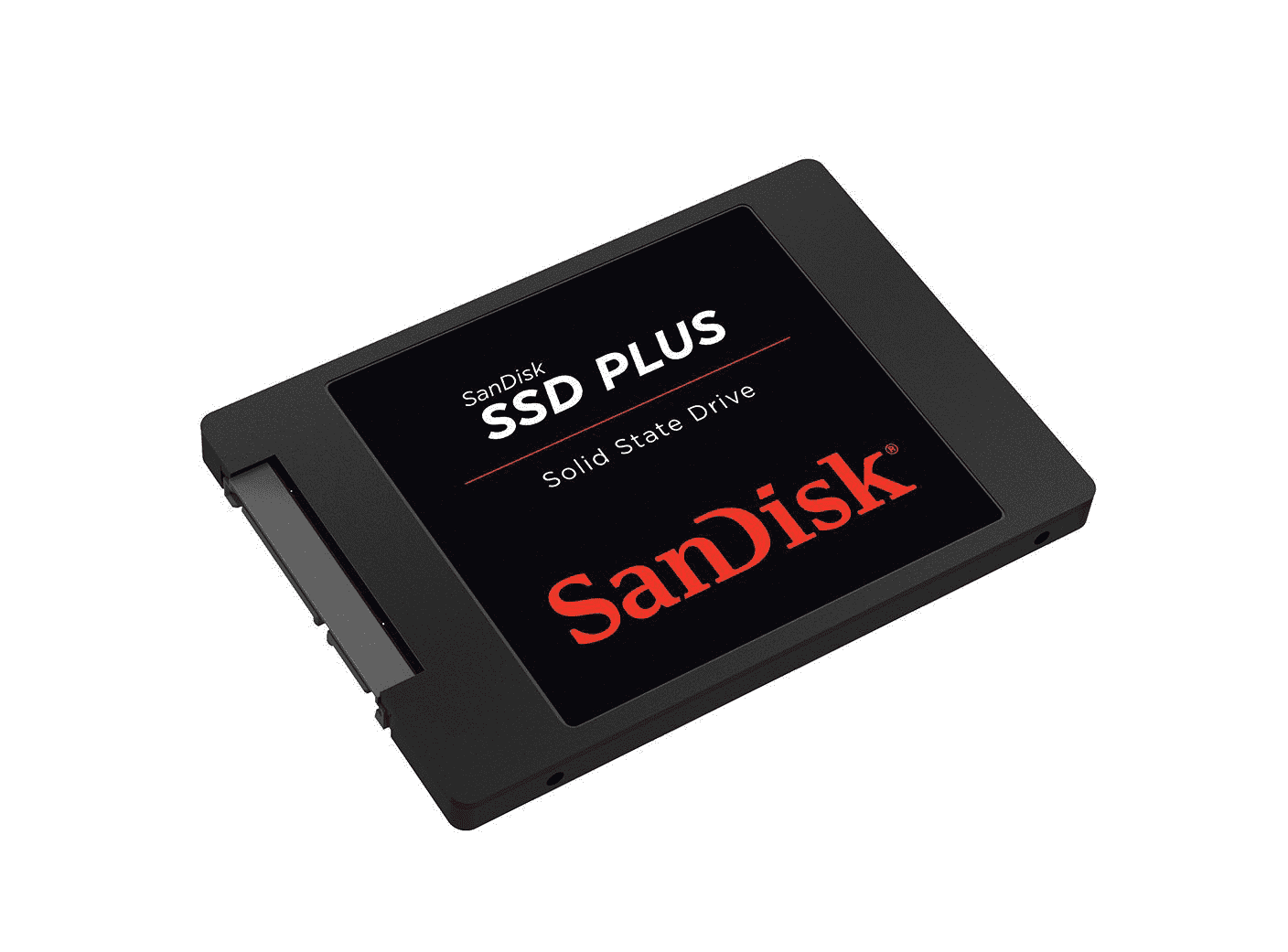
Unfortunately, this dismissive approach to core specs details makes this a product for the uninformed. It also means that there is no clarity on the subject of endurance, or for the type of flash memory technology and controller baked into the product.
The drive does deliver the approximate expected performance, but with so many uncertainties, we can’t suggest this product purchase for enthusiast users — there are alternative, unobscured options available.
SanDisk SSD PLUS 120GB Solid State Drive (SDSSDA-120G-G26) [Newest Version]
- Storage Capacity: 120GB Solid State Drive
- Read Speed: up to 530 MB/s
- Write Speed: up to 310 MB/s
- Interface: SATA Revision 3.0 (6 Gb/s)
- Dimensions: 2.75 x 3.96 x 0.28 inches (69.85 millimeter x 100.5 millimeter x 7.0 millimeter )
- Storage Capacity: 120GB Solid State Drive
- Read Speed: up to 530 MB/s
- Write Speed: up to 310 MB/s
- Interface: SATA Revision 3.0 (6 Gb/s)
- Dimensions: 2.75 x 3.96 x 0.28 inches (69.85 millimeter x 100.5 millimeter x 7.0 millimeter )
Verdict
Too much uncertainty for our liking. Look elsewhere.
Rating 3/5
SanDisk SSD Plus (240GB) Review
Try your luck or take a known quantity — your call.
Like its 120GB counterpart (left), the 240GB pulls from a range of component vendors to create the sum of its parts.
As such, there is no way for an end-user buying from a reseller to know what flash memory tech and controller pair is being used, and nor are there any available figures for endurance.
Thankfully, this 240GB unit didn’t experience the same pitifully low write IOPS in Anvil’s Storage Utilities benchmark that the 120GB unit did.
While we concede that the queue depth of 64 is a harsh test and hammers the drive with a workload that would rarely be experienced in most general end-user usage environments, it’s still a telling concern of not knowing what components are inside the unit.
While the SSD Plus 240GB delivered acceptable, albeit lower order, performance across the APC Labs tests, for the same price, you could do yourself a favor and buy the Ultra II 240GB (right) or Kingston SSDNow UV400 240GB (back over the page).
SanDisk SSD PLUS 240GB Solid State Drive (SDSSDA-240G-G26) [Newest Version]
- Easy upgrade for faster boot-up, shutdown, application load and response (As compared to 5400 RPM SATA 2.5” hard drive. Based on published specifications and internal benchmarking tests using PCMark Vantage scores.)
- Easy upgrade for faster boot-up, shutdown, application load and response (As compared to 5400 RPM SATA 2.5” hard drive. Based on published specifications and internal benchmarking tests using PCMark Vantage scores.)
- Boosts burst write performance, making it ideal for typical PC workloads
- The perfect balance of performance and reliability
- Read/write speeds of up to 530MB/s/440MB/s (Based on internal testing; performance may vary depending upon drive capacity, host device, OS and application.)
- Shock-resistant for proven durability —even if you drop your computer (Shock resistant (up to 1500G) and vibration resistant (5gRMS, 10-2000 HZ/4.9 gRMS, 7-800 HZ), Temperature (from 0 degrees Celcius to 70 degrees Celcius))
- Compatible devices: Desktop
Verdict
Too many unknowns for a product in a competitive market. There are better and safer options to consider.
Rating 3/5
SanDisk Ultra II (240GB) Review
Stuck in a tight battle with competitors.
If you’re in the market for an affordable ~240GB SSD, you could do worse than this (cough, look left).
The Ultra II 240GB specs provide the details you need and want. Well, almost — the terabytes written (TBW) spec isn’t available, but the scenario beats the SSD Plus range.
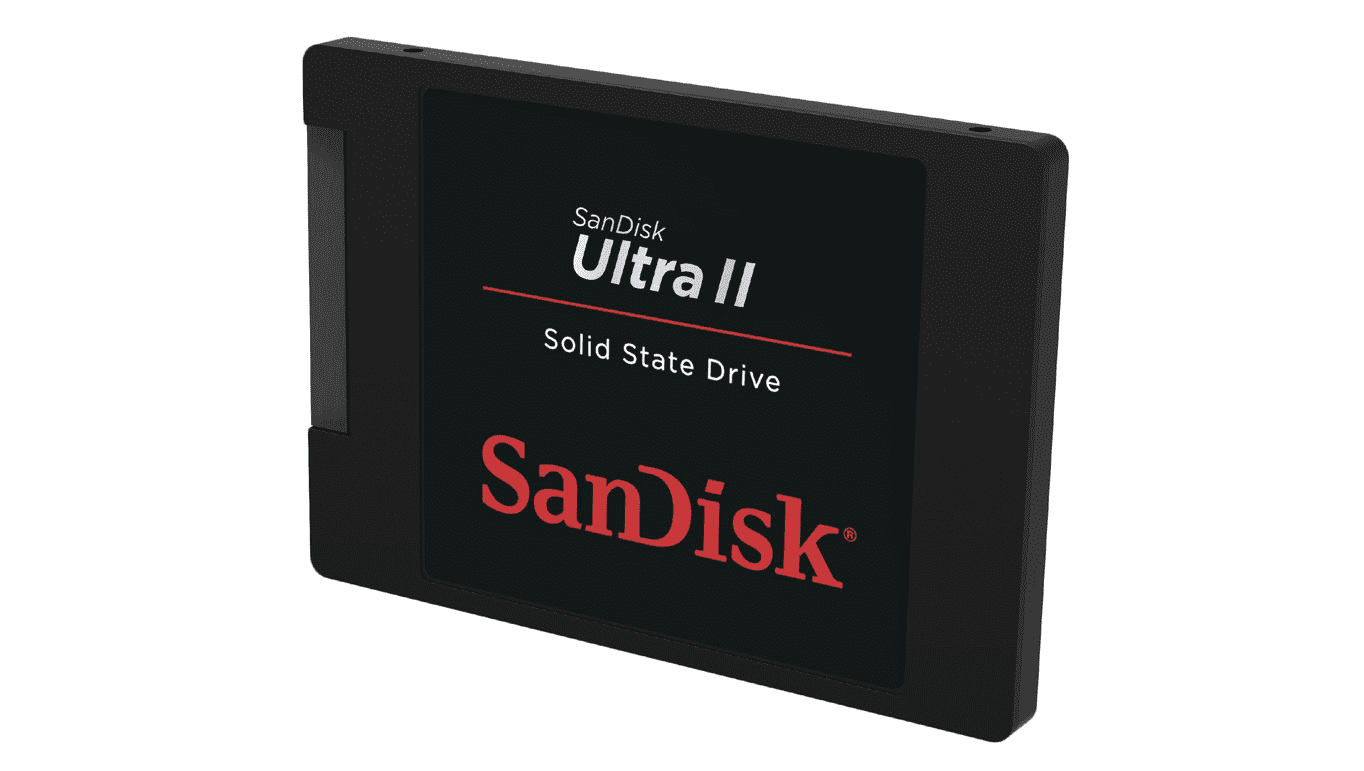
With our tests, the SanDisk Ultra II trades blows with the Kingston SSDNow UV400 240GB throughout the benchmarks suite, but it’s the AS SSD results that are most eye catching.
The Ultra II delivers impressive sustained 4K read results through a chunky queue depth of 64. Due to this result, the summarized read score is significantly boosted, which heightens the overall score. The end result is an outlier, reaching a massive 170 points ahead of the Samsung 960 Pro 256GB.
While the result is impressive, it’s a rare performance scenario that isn’t indicative of the overall performance and is worth being aware of when reviewing the test results.
SanDisk Ultra II 240GB SATA III 2.5-Inch 7mm Height Solid State Drive...
- Storage Capacity: 240 GB.
- Form Factor: 2.5-inch.
- Interface: SATA Revision 3.0 (6 Gbit/s).
- More than 28x better performance than typical HDD.
- Better overall system performance with faster application loads and better response.
- Storage Capacity: 240 GB.
- Form Factor: 2.5-inch.
- Interface: SATA Revision 3.0 (6 Gbit/s).
- More than 28x better performance than typical HDD.
- Better overall system performance with faster application loads and better response.
- Sequential Read 550MB/s; Sequential Write 500MB/s
- SanDisk's nCache 2.0 technology delivers enhanced speed and endurance
- NCQ support manages queue length for better multitasking and workload management
- Limited 3-year warranty (US)
Verdict
An appropriate offering from SanDisk for PC enthusiasts.
Rating 3.5/5
Western Digital WD Blue PC SSD (250GB) Review
Positive progress for an old platform.
For almost a decade, we’ve been asking, “When will Western Digital get into the SSD market?” and this question was answered in May, 2016, when WD completed its acquisition of SanDisk.
This action not only strengthened WD as a storage heavyweight within the market but accelerated the company’s push into the memory storage sector by giving it direct access to all that SanDisk has to offer — knowledge, manufacturing capability, the lot.

The first WD SSDs are effectively rebadged updates of current SanDisk technologies with WD branding applied. The SanDisk Ultra II (back over the page) and WD Blue drives look identical, bar the stickers. However, there is a key difference — the updated memory, controller and firmware integrated into the WD products.
In our tests, this resulted in the WD Blue returning higher write results; however, interestingly, it didn’t feature the same read spike in the 4K Q64 AS SSD read test.
WD Blue 250GB Internal SSD Solid State Drive - SATA 6Gb/s 2.5...
- Sequential read speeds of up to 545MB/s and sequential write speeds of up to 525MB/s
- An industry leading 1.75M hours Mean Time To Failure (MTTF) and several error correction technologies for lasting reliability
- Sequential read speeds of up to 545MB/s and sequential write speeds of up to 525MB/s
- An industry leading 1.75M hours Mean Time To Failure (MTTF) and several error correction technologies for lasting reliability
- Optimized for multitasking to simultaneously run resource heavy applications without system slow down
- Available in 2.5 inch/7millimeter and M.2 2280 models to accommodate most PCs
- WD FIT Lab certification for compatibility across a wide range of laptop and desktop computers
Verdict
This piece of updated tech delivers a nice level of progression.
Rating 4/5
Western Digital WD Green PC SSD (120GB) Review
A welcomed update for a new old player.
With WD’s first line of SSDs building on the foundations set by SanDisk, much of the uncertainty that shrouded the SanDisk SSD Plus range was removed and replaced with WD’s clear and concise technical messaging.
Using the updated SanDisk 15nm TLC NAND flash memory paired with a Silicon Motion SM2256S, the WD Green 120GB delivers a 40TBW quota paired with 1.75 million hours MTBF for a known quantity in terms of endurance capability. The newer solution also outperforms the SanDisk SSD Plus 120GB in write performance, resolving the cripplingly slow high queue depth 4K Q64 write speeds and IOPS witnessed across AS SSD and Anvil’s Storage Utilities.
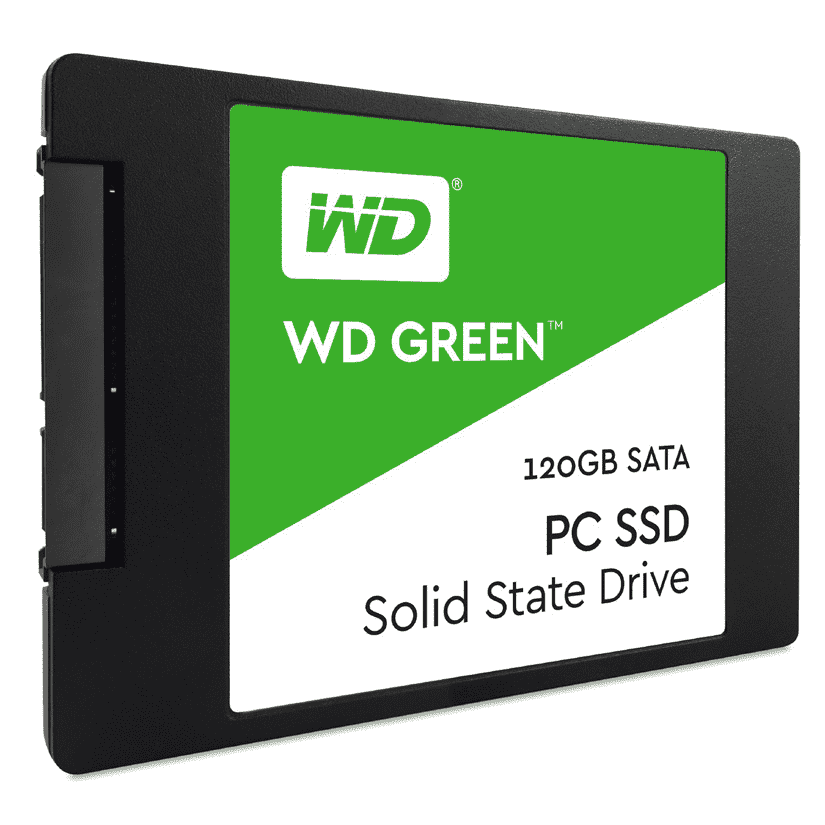
Though the SanDisk SSD Plus looks similar to the WD Green, they’re worlds apart in terms of implementation and spec transparency. This is a welcome move from WD. We look forward to future iterations.
Verdict
Building on the shoulders of SanDisk, WD has made a welcome update here and a positive first step.
Rating 3.5/5
Western Digital WD Green PC SSD (240GB) Review
For the valueorientated buyer.
The WD Green 240GB achieves the lowest cost per GB, coming in at just $0.50 and doing so with performance that doesn’t make you dismiss the drive as a low-cost, low-quality unit.
While it nailed the low-cost elements, the quality appears to be present.
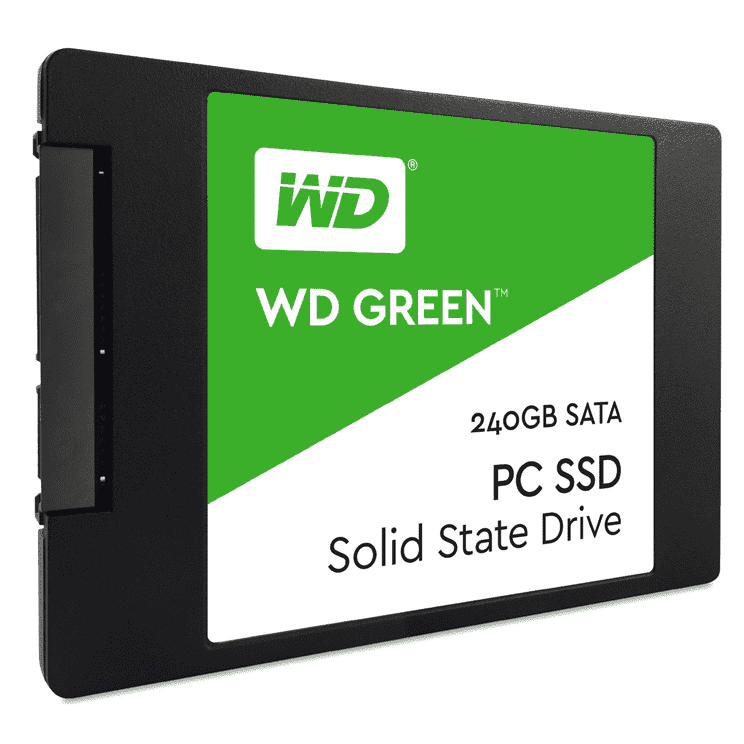
The Green’s performance isn’t going to pinch the lead from Samsung, but for the cost, this model hasn’t delivered a completely undesirable option from a performance standpoint. The unit does enough to get a nod and doesn’t sweat it over much more than that. As long as you buy knowingly, understanding the entry level positioning of the unit, buyer’s remorse shouldn’t be an issue.
WD Green M.2 2280 240GB Intern
- Wd Green Wds240g1g0b 240 Gb Internal Solid State Drive - Sata - 540 Mb/s Maximum Read Transfer Rate - 465 Mb/s Maximum Write Transfer Rate - M.2 2280-none Listed Compliance
- Wd Green Wds240g1g0b 240 Gb Internal Solid State Drive - Sata - 540 Mb/s Maximum Read Transfer Rate - 465 Mb/s Maximum Write Transfer Rate - M.2 2280-none Listed Compliance
The WD Green 240GB has improved upon the position of its predecessor, the SanDisk SSD Plus 240GB (back over the page), though still can’t take the battle to other drives in the ~240GB category. For $10–$20 more, a better solution is available, but if every dollar counts, then the WD Green gets the job done.
Verdict
At $0.50 per GB, the WD Green 240GB offers great value with respectable performance traits.
Rating 3.5/5
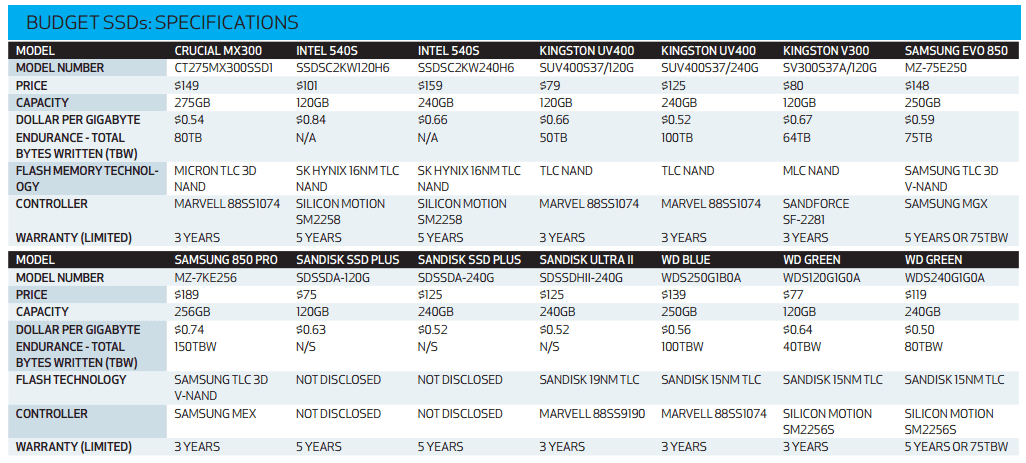
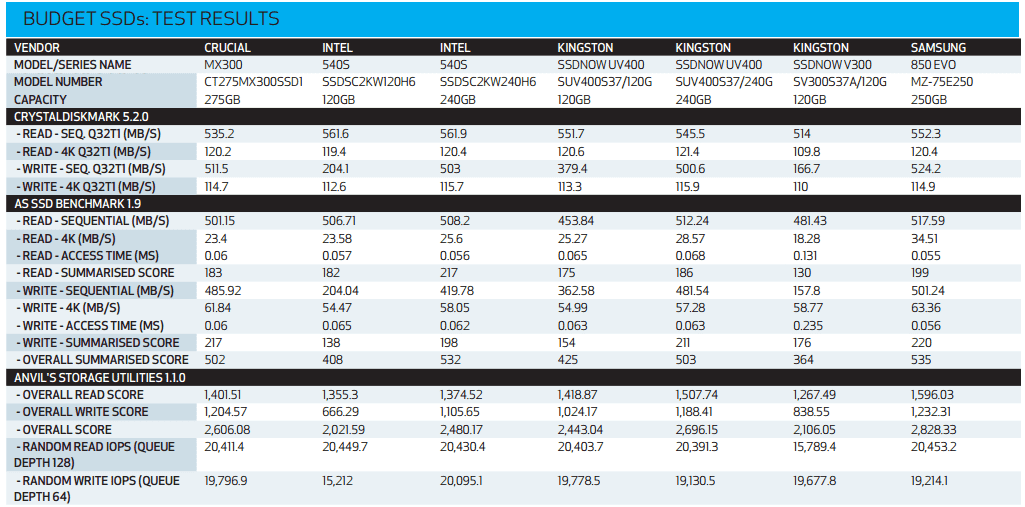
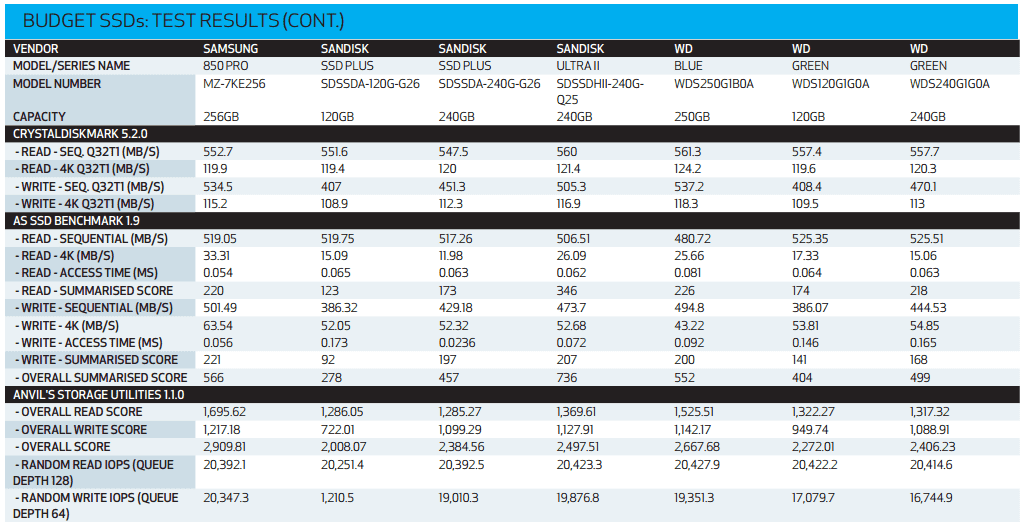
































![SanDisk SSD PLUS 120GB Solid State Drive (SDSSDA-120G-G26) [Newest Version]](https://m.media-amazon.com/images/I/41Z6t6ihO5L._SL500_.jpg)
![SanDisk SSD PLUS 120GB Solid State Drive (SDSSDA-120G-G26) [Newest Version]](https://m.media-amazon.com/images/I/41+EBaSo2bL._SL75_.jpg)
![SanDisk SSD PLUS 120GB Solid State Drive (SDSSDA-120G-G26) [Newest Version]](https://m.media-amazon.com/images/I/41fzCrz4bIL._SL75_.jpg)
![SanDisk SSD PLUS 120GB Solid State Drive (SDSSDA-120G-G26) [Newest Version]](https://m.media-amazon.com/images/I/41ZF9GrCAQL._SL75_.jpg)
![SanDisk SSD PLUS 240GB Solid State Drive (SDSSDA-240G-G26) [Newest Version]](https://m.media-amazon.com/images/I/31K62jag2KL._SL500_.jpg)
![SanDisk SSD PLUS 240GB Solid State Drive (SDSSDA-240G-G26) [Newest Version]](https://m.media-amazon.com/images/I/31zGI+o7bNL._SL75_.jpg)
![SanDisk SSD PLUS 240GB Solid State Drive (SDSSDA-240G-G26) [Newest Version]](https://m.media-amazon.com/images/I/41I45fCTqLL._SL75_.jpg)
![SanDisk SSD PLUS 240GB Solid State Drive (SDSSDA-240G-G26) [Newest Version]](https://m.media-amazon.com/images/I/51HC8pFqmDL._SL75_.jpg)
![SanDisk SSD PLUS 240GB Solid State Drive (SDSSDA-240G-G26) [Newest Version]](https://m.media-amazon.com/images/I/51omkM7JbSL._SL75_.jpg)
![SanDisk SSD PLUS 240GB Solid State Drive (SDSSDA-240G-G26) [Newest Version]](https://m.media-amazon.com/images/I/51QsEGaOh2L._SL75_.jpg)
![SanDisk SSD PLUS 240GB Solid State Drive (SDSSDA-240G-G26) [Newest Version]](https://m.media-amazon.com/images/I/41hdjTX2rDL._SL75_.jpg)








